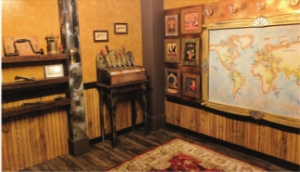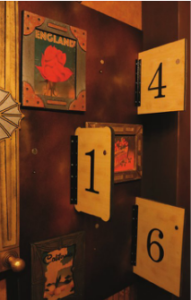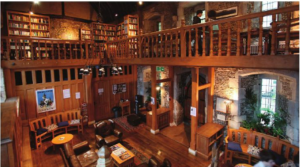FEATURE: Escape artistry
Escape rooms have had healthy growth worldwide in recent years, but times are changing – smaller operators are being squeezed out while the product itself is evolving. Jon Bruford spoke to a number of leading protagonists to find out what holds the key to success…
Escape rooms are generally thought of as a small-scale amusement, one that entertains quite a small number of people for quite a long time; generally four to six people are occupied solving puzzles for up to an hour.
With those numbers in mind, it’s fair to say nobody is really getting rich running a single escape room anywhere right now. But great minds are working on the solution for that small throughflow of customers, and escape rooms are on the cusp of great change.
The appeal of the product is simple, says escape room architect Adrian Fisher, founder and chairman of Adrian Fisher Design: “People love the idea of solving a series of challenges or puzzles, and in one sense we have been doing this with maize mazes for 25 years; you go into a cornfield and you have a series of challenges, with the objective to get out of the maze within the hour. Escape rooms are good because they’re on the spot, and you can do it with your friends, and you have a series of challenges.”
Historically, many escape rooms have been a single room kitted out with a ‘theme’ which is largely off the shelf and lacks original identity; supplementary materials may be videos from YouTube, or if the players are lucky, a PowerPoint presentation.
These setups suffer from a lack of replayability and that’s part of the reason many are going to the wall, says Escape Room Master’s Nate Shane: “The big issue is there is no replayability in the games – once somebody comes and they play two of your three games, they only have one more to play and they may come back, they may not. So constantly changing or adding new games is a big driver to keep people coming back, as well as drive more throughput. A facility with eight games over one that has three games can cater to a much greater number of players.”
Shane added: “We have seen a lot of smaller shops closing in recent months, people can’t keep their doors open due to lack of space, funds, maybe poor planning, not enough bookings compared to larger competitors that have the reserves to ride out a rough patch. I think you will see a lot of smaller escape rooms close their doors in the coming months, and see the really good small rooms be acquired by larger players and replicated everywhere.”
Escape rooms 2.0
 So if you’re looking at an escape room for your venue, have you missed the boat? Not at all, say our sources.
So if you’re looking at an escape room for your venue, have you missed the boat? Not at all, say our sources.
FECs are, if anything, under-served in this capacity, as Creative Works’ chief marketing officer Danny Gruening, explains: “Escape rooms is an area of growth. I believe – from what we have heard at IAAPA – that escape rooms in general have been doing very well in the UK, and that’s been happening in the US too over the last couple of years. It’s been a growth area in general, but we service more often than not family entertainment centres. They have a number of attractions, usually something like bowling or laser tag, or go karts, and for us that’s where the growth is really happening. We felt FECs had been largely ignored by the existing options in the market.
“A lot of the existing escape room companies are actually selling franchises, and they are targeting mainly people that want to open an escape room business; in the FEC world, almost no-one does franchise attractions because it doesn’t make any sense for them to have to pay a franchise fee and then pay royalties every month. We wanted to provide an attraction they could treat like the rest of their attractions, where they can pay for it and keep everything they make, and have the escape room be a part of a greater whole.”
But to survive, the form has to evolve into something more practical that can service a greater number of people, more quickly – and that’s just one of the issues. Adrian Fisher’s company has been working on the problems.
He tells GAP how they have solved many problems with the escape room form: “Escape rooms at present have a few slight problems. We have come up with a solution that means you can walk up and go right in, you don’t have to book days in advance; but a lot of escape rooms only have capacity for four or five people an hour and you only have one room, hence you have to book. That doesn’t help if you’re running an attraction on a boardwalk, you want to accommodate everybody, especially people walking by.
“The second thing we addressed is capacity. Our mazes have a capacity of about 400 people an hour, which is a lot better than five or six people. But with a maze you can set things up precisely and it works; an escape room needs to be reset every hour or whatever, because of the puzzle element. And of course, it has to be set up correctly – it’s human nature to make mistakes, it happens. If you could have a system that can set itself, that’s one of the holy grails, and that means you can have staff greeting customers and ensuring their experience is good.
“Wouldn’t it be great if you had a setup that meant there were over 500 combinations, and no team goes in to find the same thing? That means no cheating, no collusion between visitors, every group has a different objective. Wouldn’t it be exciting if you had two or three different stories going on in the same building at the same time? You have a building that feels like a mansion and one group are on a spy mission, another are hunting for ancient Egyptian treasure, while some others are tracking a murderer, all doing their own thing at the same time.
“That’s what our Magic Mansion Mysteries project is. Our first example opens in the Middle East this year.”
Time
One of the other issues for the escape room format is time. Many rooms have a time limit of one hour, to which you then have to add reset time for the next group, so you may be looking at 75-90 minutes per group. Larry Kirchner, president of Blacklight Attractions, says: “You could build a really large escape room that can hold 12 people; all the ones we have been building hold ten people or more, but we have built rooms for other people that can hold only eight. The most successful that I know of in the US is in Washington DC, and they have a 45-minute escape room, so they can turn their room over every hour on the hour. Most other rooms run to 60 minutes, so they can only run a new group every 75-90 minutes. Other people are building rooms with two – or three-minute escape rooms, a super-fast turnover. There are a lot of ways to do it, but if you want to get into the escape room business, you may want to run it at about 45 or 50 minutes. I know people who are making $10,000 a day, that’s more money than any family funfair will make from anything they have.”
There is also an issue with staff that relates to time – that reset has to be done by someone, and it has to be done right. Is there the technology and potential to automate this part though, and with that, to speed it up so we can see greater, quicker returns?
Yes, but not quite yet, says Nate Shane, whose Escape Room Master company creates the software that can help you run your room much more effectively. He tells us: “Automated reset is an awesome idea, but if you want anything physical in your escape room – like a player unlocking a box and taking out an item, for example – as soon as you go into that realm, you have something that needs to be reset. It’s a matter of how much do you want to have to reset; a one-button-push reset kind of game is entirely realistic but if you’re going to have anything that opens without a piston on it that you can close automatically, it’s going to be a pain. It would be difficult but do-able to build s uch things, I have a lot of ideas for that but the cost is non-trivial compared to the average escape room build cost. If someone opens a little door, it has to be closed every time.”
uch things, I have a lot of ideas for that but the cost is non-trivial compared to the average escape room build cost. If someone opens a little door, it has to be closed every time.”
Jonathan Plache, CEO of Veqtor UK, which creates electronic support for escape rooms, agrees with Nate, elaborating: “It’s still very labour intensive; one of the Holy Grails is auto-reset. I think that will probably never be completely reached, because one of the integral elements of escape games and puzzle rooms is the physical nature, and there will always be a number of physical elements that probably do need some level of reset. But you don’t want a 15-20 minute reset if you can have a 30-second reset instead. The escape game has to move toward almost resetting a dinner table for the next service – go to a restaurant and the team will be able to do that very rapidly. That’s more where we should end up.
“The second Holy Grail is change. The room might be the same space but elements of the escape change from game to game. You then have the ability to come back to that room, and may know where some clues are, but to get back into those clues it’s as difficult as it was the first time you came; some of the clue inter-connections have now changed so you can’t assume anything.”
Licensing
Licensing might not be obvious in escape rooms as there is such a wealth of generic material to use, but Larry Kirchner’s Blacklight Attractions has been at the cutting edge of that sector, though he admits it’s not essential as the facets of a license you need could be done for free: “We recently built a set of escape rooms that were licensed – we did Friday the 13th, and I came up with the concept that you’re not trying to escape, you’re just trying to buy time so the police can get to you to save you; you’re figuring out ways to lock the doors, windows et cetera.
“We did another based on Ghostbusters, where you’re trying to trap the ghost and save the city; we did a Teenage Mutant Ninja Turtles one too. I think licensing would help sell more tickets if it became more widespread, but I don’t think it’s absolutely necessary. There is a lot of generic material out there to make a great theme with. James Bond would be a great theme, but you could easily do a really excellent spy theme without that branding.”
Something everyone we spoke with agreed on was that frequently, escape rooms were strong in one area and weak in others. For example, the concept may have been thought up by someone with an eye for set design, but whose strength is far from creating the puzzles, or the story that links everything in the room. If you think of this like branding, or even like making a movie, it’s clear that each aspect is as important as the others, as Larry Kirchner summarises: “Most people that build escape rooms have no clue as to how to create a themed environment. You might have someone that is great at making a story or a puzzle, or clues or whatever, then that has been thrown into a room that is not themed to match that story. You might have someone who has tried to build a haunted house and they’re really good at working out how to scare someone, but they have no clue as to how to design the thing they are selling. The same thing happens with escape rooms, often you might have a great puzzle but you don’t feel like you’re trying to escape an asylum. Maybe you don’t have the best clues but I think it’s better if you land right in the middle, with really good themes, good puzzles, rather than being strong in one area and weak in another. We’re lucky in that we are great at all aspects of the escape room, we are Hollywood quality with our theming.”
Survival
It seems that, for all of the success of the escape room, the format needs quite a bit of change if it is to continue – but it is almost certain to survive and even thrive, as innovators like these tackle the issues preventing the growth of escape rooms. Jonathan Plache is confident because it’s all about mixing with other people, and using your collective brains to escape and achieve – but it has to be on a scale that means it can work commercially.
 He says: “Now the larger players are trying to have much more commercial grade equipment that can withstand a higher flow of customers and much speedier gameplay. This is driving organisations such as ours to get into the market to supply products that support that higher through-rate demand.
He says: “Now the larger players are trying to have much more commercial grade equipment that can withstand a higher flow of customers and much speedier gameplay. This is driving organisations such as ours to get into the market to supply products that support that higher through-rate demand.
“Seven people an hour is just too slow for theme parks or amusement centres; different types of escape, or what we refer to as a puzzle room, are starting to grow out of this changed demand. Therefore they need robust electronics.
“When you have a new industry – it’s only five or six years old – it’s developing and finding its feet, and suppliers are trying to improve and develop the industry. You need the escape experience, but perhaps in a micro taste rather than a one-hour experience. I think in the future we will see highly themed, more entertaining escapes and puzzles where people spend maybe 15 minutes, with rooms interconnected that people can move through and race to solve the puzzles.”
We’ll leave the last word to legendary maze designer Adrian Fisher: “Some of the major players, with theme parks that get 10,000 people a day through their gates, cannot cope with the idea of a product that only allows you to serve 4-6 people an hour. Even if you had ten rooms, that’s only 40 to 60 people an hour! That’s allowed a lot of individual owners to set up a smaller experience, in one room, all over the world – but that’s not exactly an industry, is it? Though we have 1,500 escape rooms around the world, which clearly proves they are a great thing, they don’t make a lot of money at the best of times – therefore we want a model that makes lots of money and excites the owners, and they get their return on investment much faster – maybe in under a year.”
